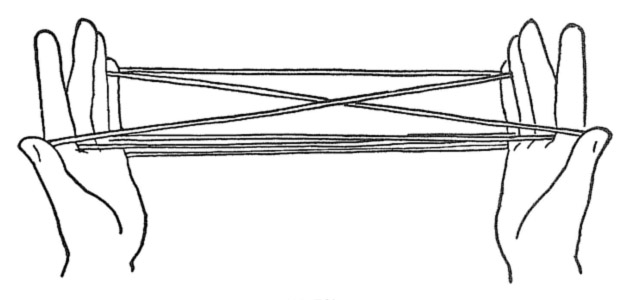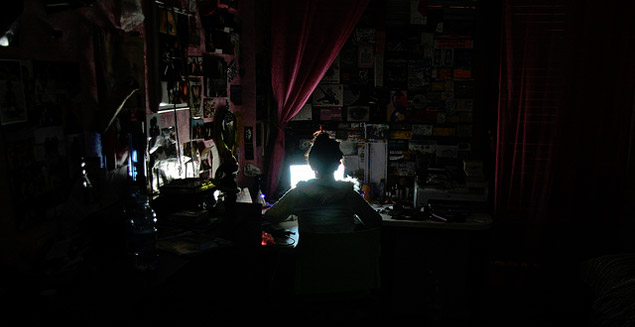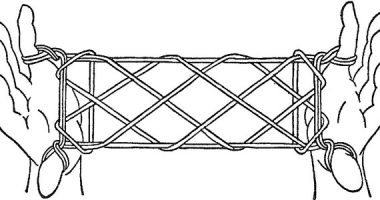
Illustration from String Figures and How to Make Them, by Caroline Furness Jayne (1906). Source: Wikipedia.
Everything that we think of as the Internet 2.0 –social media, basically– has brought about a revolution in our practices of interaction, communication, research and production of information, and in the way we manage our identities and our everyday lives. The advent of smartphones and the universalisation of the Internet have conditioned many aspects of our lives, and also those of children and teenagers, who are often a reasonable cause for concern. On one hand, these technologies offer new ways of interacting and displaying ourselves socially; and on the other, they change core processes that have to do with the way we operate individually, as citizens, and as part of a community. While it is true that nobody in adult or professional worlds doubts the advantages and opportunities that this new environment offers, when we turn our attention to children, teenagers and young people we are beset by worries: Is the net a safe environment? When does moderately high usage become excessive – and therefore damaging? Where is the fine line between dispersion and the ability to multitask? And many more. In the first part of this article, we will look at some possible problems we may encounter.
The period from the late twentieth century up until the present is undoubtedly turning out to be a time of technological revolutions. The use of the Internet by ordinary citizens is a relatively new phenomenon, dating back less than two decades, but has already been deeply absorbed into our patterns of working and socialising. The ‘Global Village’ that Marshall Luhan talked about in The Medium is the Message (1967) has become a benchmark to work with now more than ever. In Life on the Screen (1995), the psychologist Sherry Turkle discussed the changes that the Internet would bring not just to the field of communication, but also in other basic aspects of our selves (identity, relationships, etc.), but her words have become outdated in a very short time. They pale before the speed of its evolution in terms of the way it is presented and develops, a speed that often makes it difficult to stop and think about the ways we use it.
Technological innovations always generate new scenarios, which trigger different responses. Resistance to change is a key element of any cultural and communicational revolution, and we are currently in the midst of a major one. In an earlier post on this blog, Cristina Sáez explained how writing already gave Plato headaches (he said we would lose the capacity to think if everything was written down for us), and how the invention of the printing press was a magic step forward for knowledge that certain elites found hard to accept (the device for the expansion and reproduction of culture invented by Gutenberg questioned certain cultural hegemonies).The article ‘Millennials will Benefit and Suffer due to their Hyperconnected Lives’ (2012), by Pew Internet Research looks at the way several experts imagine the future, bringing to light two clearly opposing positions: the optimists who celebrate the new opportunities that are arising, and a more pessimist and critical group that sees possible problems that they may end up triggering. In addition, “digital natives” and “ digital immigrants” have to coexist and read in the same spaces, even though our starting points are different. But before focusing on the problems, we should keep two important points in mind.
Firstly, we should be wary of the tendency to create problems based on new categories such as ‘nomophobia’, ‘sexting’, ‘bullying’, ‘phubbing’ and ‘grooming’, to name just a few of a long list of neologisms. And we should also take care not to make the mistake of thinking that certain social networks have come about as a result of the emergence of the Internet in recent years, ignoring the structural issues that have been with us for years. For example, bullying amongst teenagers is an issue that has been around for years, and that we have now come up against head on. And not because of the ‘double check’. Mixing up the meaning of media is like getting to the summit without appreciating the path that has led us there.

Font: Paul Wash.
Secondly, the world that surrounds children, teenagers and young people tends to initially provoke responses in which control prevails over processes of change or new social interaction practices. Professionals who work with teenagers and young people, like myself, are likely to initially find it easier to formulate discourses full of rules, regulations and restrictions rather than enter into a new world. As Jaume Funes says, “we always start by looking for a way to disqualify everything that overwhelms us or that throws our pedagogic and didactic structure off balance.” As we know, the problem is not that most types of control are useless, but that they are difficult if not impossible to enforce. The sociologist Manuel Castells never ceases to repeat that the advantages of the revolution far outweigh its disadvantages: it increases sociability – not the opposite – in two interdependent worlds: the digital and the physical. Meanwhile, Dolors Reig suggests that the true crack is in the realm of learning, not the digital realm. In fact we can link it to the eternal warning expressed by Jaume Funes, who says that the real current crisis – the issue we are dealing with here – lies in teaching, not in teenagers.
Numerous authors have studied the new processes emerging from the use of the Internet and their principal effects. We should take the following points into account:
- Internet use has become a widespread practice: a majority of people regularly go online in their everyday lives (The Cocktail Analysis, 2012), for many different reasons (work, entertainment, etc) This finding applies to different age groups.
- There are major changes taking place in the way we relate, in the broad sense of the word (Reig, 2011; Castells, 2007). We can now access new ways of interacting and displaying ourselves, and at the same time, some very basic elements of the way we operate are being transformed: the way we process and filter information, memorisation and learning processes, and even classic participation mechanisms and our notions of privacy and intimacy. Many research projects are studying the effects of these new mechanisms.
- Some forms of use may turn out to be problematic and are now in the study phase because they are so new, or undergoing transformation and altering the scope of problems we are familiar with. In our professional community – social work, education, psychology and health care – three types of problems are of particular concern: (1) those linked to overuse and/or possible dependence (Carbonell, Fúster, Chamarro i Oberst, 2012); (2) those regarding the relationships issue –cyberbullying and similar – (Avilés, 2013), and (3) those that have to do with consequences of the simultaneous and convergent use of different screens (Jenkins, 2008).
- In order to carry out preventative work, we need tried and tested strategies to address and prevent these uses. It is necessary to explore this issue further and think about possible channels and methodologies of work, and also the influence and usefulness of professionals who work with teenagers and young people (Funes, 2010).
Main characteristics of social media use by teenagers

Font: Federico Morando.
There are many issues concerning the use of screens (smartphones and others devices that connect to the Internet) by teenagers and young people. Some of the key considerations to be taken into account are:
Elements that shape their identity, based on two worlds – the physical and the virtual – that have merged and complement each other
For years, Sherry Turkle (1995) has been carrying out in-depth studies of the notion of identity on the net. Initially, she talked about the existence of two identities: the virtual self and the “real” self. This may have made some sense within the logic of her study at first, but it did not adapt very well as the phenomenon evolved (it focuses mainly on games like Second Life). So in her later works she has modified it, influenced mainly by the emergence of smartphones (Alone together, 2011). A recent study by Busquet and other authors (2012) states outright that “young people and teenagers value the net as a continuation of the real world, while parents see it as a different place”. Which means that the distinction between real and virtual identity is the adult construct of a generation that has lived through the ‘before’ and ‘during’ the Internet. For the current generation of teenagers and young people – the first to have been born into a world in which the Internet already existed – this distinction is not so clear. On the contrary, they are entirely complementary identities, which now contribute to the formation of their overall identity or ‘self’. Jaume Funes (2012) wrote that “for the majority of today’s teenagers, few things make sense if they do not make reference to them. They exist in as far as they are “online”, and they exist in as far as they are images. There is no identity if there is no virtual media profile. There is no sociability if there is no digital interaction.”
Essentially relational use
Access to a smartphone or an Internet connection have become key to being able to socialise (González, M. et al., 2006). Being online is a mechanism for social interaction like any other, an extension of the ‘physical’ world that can be used to arrange to meet up in the town square, to continue a conversation that began on the street, or for other purposes such as flirting, talking, making dates, arguing, etc.
Ever-changing tools and media become consolidated
As we were saying, the technological revolution is developing extremely rapidly. In The Medium is the Message (1967), McLuhan already predicted that these new environments would be accompanied by vertiginous speed. As I write these words, Facebook usage metrics show that many young people are migrating to Twitter, basically to escape adult control. These constant changes take place on different platforms, and they tend to converge (Jenkins, 2008). As such, it is more relevant to talk about social networks and the Internet in general than about specific applications.
Girls and boys use the net differently
If there’s one issue that different authors agree on it is the fact that boys and girls tend to use the Internet differently (Bertomeu, 2011; Castaño, 2009; González, M. et al., 2006). The gender issue is key in as far as it is reflected in different forms of use: for females, communication comes to the forefront. Girls talk more and tend to use applications based on instant messaging. Meanwhile, boys are more partial to games (videogames, MMPORPGs, etc.) and to going online for recreational purposes (entertainment).
Changes in the connected teenager: multitasking, memory, information processing, reading, etc.
Dolors Reig (2013) writes about the effects on the key classic learning and social dynamics on teenagers. Studies show that teenagers and young people are more likely to carry out many low-complexity tasks simultaneously (Rosen, 2008). Reig mentions:
- Small (2009) and his studies that show increased speed in problem solving and (operational) decision-making in connected subjects.
- Sparrow (2009) who finds that the online environment modifies basic information processing tasks (we no longer need to memorise aspects that we know we can find online).
- Lunsford (2008), who works on new directions in digital literacy; Bauerlein (The Dumbest Generation, 2009), who develops the concept of ‘the next idea’ – new types of unmeditated, quick expression that move on to the next idea without going beyond the surface.
- Deresiewicz (2012), and his concept of ‘infonivorous’ humans: multitasking as a strategy for adapting to the environment.
We clearly need new formulations to describe this new connected individual (Reig, 2011). Meanwhile, some authors are questioning the possible consequences of these new systems. De Pagès (La Generació Google, 2012), for example, takes a critical view of these new learning and information management processes, considering them to be superficial and lacking in depth.
The smartphone as an integrated device
Unlike earlier mobile phones that were mainly used for making phonecalls, teenagers and young people use smartphones in a totally different way. The smartphone is the device that boys and girls use to keep their socialising activities and their relational processes active 24 hours a day (González, M. et al., 2006). As such, it becomes an extension of themselves. An appendix, as McLuhan would say.
The public display of identity: rethinking privacy and intimacy
The issue of online data and rights is one of the key concerns about the ‘dark side’ of the Internet. These rights exist, but they are based on two very different approaches: (1) a juridical-legal perspective that focuses on the protection and security of our online identities and on the overall functioning of the 2.0 environment; and (2) a psychological, educational and/or social perspective, which is more relevant to us here.
Digital identity and the relational aspects that go with it have revealed new forms of interaction in digital space and, consequently, public space. After all, it reorganises core aspects of our private lives. Reig (2011) introduces the concept of ‘abundant privacy’ to describe the way in which we publish our life online, conditioned to some extent by our actions and intentions. This becomes extremely important in the world of teenagers. While the socialisation of those of us who are now adults took place in the framework of the protection of our privacy, we now have to ask what this means in the current context. The exponential nature of the net, the speed at which content is transmitted, and the potential scope of this content can open up many opportunities. But they can also become a source of headaches unless a minimum level of control is applied, particularly in aspects that have a bearing on their future academic and professional lives and digital reputations.
We constantly question the fact that young men and women (as well as many adults, although we tend to overlook this) publicly exhibit themselves on their walls and timelines. It scares us to think that those images may trigger obscene thoughts in disturbed minds, or problems in an already difficult future employment scenario. But increasingly, we will have to accept that both the individual realm – including the body – and our relationships – which have become ‘liquid’, to quote Zygmunt Bauman – are part of this new cultural and relational system. In this sense, many people – including teenagers – use smartphones as means to share and shape their perpetually interacting, multiple, provisional identities. This still leaves much to be said for another time (another post, side, work, latitude, etc) about the current state of our data and our rights.
These technological innovations are full of potentialities, and problematic uses may arise. For this reason, we need to develop a preventative, educational discourse around them. In the next post, we will look at how to encourage responsible usage and promote autonomous, critical users, and at the same time set up basic mechanisms for preventing and dealing with the risks and problems that stem from these new technologies.






yorlenis | 15 January 2014
muy interesante tu investigación .
Luis Huertas | 17 January 2014
Se prevee que en el futuro el uso de las red de redes va a dominar al ser humano, en la cual se acoplaria el celular con una base de datos en un chip de almacenamiento en la, en el año 2020, a un cerebro humano, sel ser humano sera digihumano tendria mucha capacidad y rapidez para decidir en grandes proyectos , pero a la vez dicho cerebro podra ser bloqueado o dominado por una supercomputadora.Surgiendo nuevas ciencias medicas aplicadas al digihumano.
Saludos
Luis Huertas – Piura Peru
Gracia | 03 June 2014
Hola!
Soy pedagoga y orientadora escolar. Estoy diseñando un taller sobre “Buen uso y Seguridad en Redes Sociales” y me resulta muy útil tu aportación. Gracias por tu trabajo!
Gracias
Equip CCCB LAB | 03 June 2014
Hola y gracias por el comentario. Nos alegra que te interese.
De hecho puede serte de utilidad toda la información sobre el ciclo UNIVERS INTERNET en: http://www.cccbeducacio.org/es_ES/web/guest/activitats/-/institut/a_10364 Y la continuación del artículo de Jordi Bernabeu en https://lab.cccb.org/eslaprenentatge-a-la-xarxa-2-entre-laccio-preventiva-i-educativa/ Igualmente, te recomendamos que consultes el blog de SOBRE PANTALLES en http://www.sobrepantalles.net/
Suerte con el Taller y gracias por contactarnos.
Leave a comment